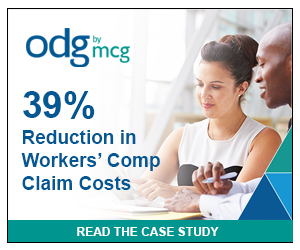News Articles
Friday, March 16, 2018
Medical Inflation a Growing Threat to Comp Profitability, Speaker Says
- National
- Topic: Top
- - Popular with: Insurance
- - 3 shares
LAS VEGAS — As workers’ comp premium rates have been on a downward trajectory since early 2015, a rating bureau official said on Thursday that increases in medical inflation could provide a clue as to when rates will rise once again.

Bill Mudge
Bill Mudge, president and chief executive officer of the California Workers' Compensation Insurance Rating Bureau, said that trend lines for medical inflation and workers’ comp charged rates in California “eerily mirror each other” — although shifts in premium rates tend to lag those of medical inflation.
“Medical in our view drives a lot of everything in comp,” Mudge said. “Follow that medical inflation trend and that might be a relatively good economic indicator about where rates might fall.”
Mudge’s comments came during a workers’ comp rating board panel discussion that was part of the American Society of Workers' Compensation Professionals, or AmComp, conference in Las Vegas. The conference continues today.
The other panelist was Jeremy Attie, president and chief executive officer of the New York Compensation Insurance Rating Board. The session was moderated by Bonnie Piacentino, senior vice president of the Pennsylvania and Delaware compensation rating bureaus.
Attie said the medical inflation trend might not have as much of an impact in New York, where medical expenses make up only a third of workers’ comp costs, and indemnity accounts for the other two-thirds.
In another conference presentation, David Sampson, president and CEO of Property Casualty Insurers Association of America, said medical inflation poses a threat to profitability of the workers’ compensation insurance line.
Health care costs are projected to increase 6.5% this year, more than three times the increase in the consumer price index, Sampson said. And hospital prices grew in December at the fastest rate in four years.
Sampson said tools including utilization review, fee schedules and treatment guidelines can help rein in the “runaway costs” of medical care. And citing success seen in Texas in implementing a workers’ comp prescription drug formulary, Sampson said PCI supports formularies that work in concert with evidence-based treatment guidelines.
Prescription drugs account for 17% of workers’ comp medical costs, Sampson said, referring to National Council on Compensation Insurance figures.
“For states considering formularies, we believe now is the time to move forward, and build on progress that’s been made so far and the demonstrated results in states that have pursued such options,” Sampson said.
Sampson said impacts to workers’ comp costs might also come from actions at the federal level, including efforts to dismantle the Affordable Care Act.
“If the ACA is unwound with no effective system to replace it, cost-shifting to workers’ compensation coverage is a big threat,” Sampson said.
Sampson’s presentation detailed what he called the top eight issues for the workers’ compensation industry in 2018. In addition to medical inflation, those included legislative and legal developments, the opioid crisis, marijuana legalization, technology, and employment law as it pertains to the gig economy.
During the rating bureau session, panelists talked about how the role of their organizations has changed over the years.
While in years past, the rating bureaus were sometimes at odds with state regulators, the speakers said relationships have improved. Mudge said regulators are looking for transparency, which WCIRB provides through meetings that are open to the public as well as posting information on its website.
Attie said pricing regulatory proposals in a way that is easy to understand has improved relations with regulators.
“We’ve developed an enormous amount of goodwill,” he said.
Although many states turn to NCCI for insurance rate and loss cost recommendations, Mudge and Attie said it makes more sense for some states, including California and New York, to have their own rating bureaus due to the uniqueness of the states.
Today’s News
- Neb. - Divided Supreme Court Reinstates Occupational Disease Claim for COVID-19 Top 04/23/24
- Texas - High Court Orders Further Proceedings on Truck Driver's Status as 'Employee' SOUTH 04/23/24
- N.Y. - Court Upholds Denial of Summary Judgment on Claims From Alleged Elevator Mishap NORTH 04/23/24
- N.Y. - No Summary Judgment for Worker on Labor Law Claims NORTH 04/23/24
- S.C. - Senate Passes Resolution to Approve Electronic Payments SOUTH 04/23/24
- Colo. - Committee Passes Bill to Strip State's Right to Self-Insure WEST 04/23/24
- Calif. - DWC Updates Time-of-Hire Notice WEST 04/23/24
Advertisements
Now Trending
- Workers' Compensation News
-
Calif.
Chiropractor Sentenced to More Than
54 Years, Fined…
Posted on Apr 16, 2024
-
Calif. Court
Upholds Summary Dismissal of
Worker's Claims for Retaliation,…
Posted on Apr 17, 2024
-
Calif. WCIRB
Approves Recommendation for 0.9%
Rate…
Posted on Apr 18, 2024
-
Calif. Committee
Passes Bill to Expand 4850…
Posted on Apr 22, 2024
-
Calif. Committee
Passes Bill to Revise Poster…
Posted on Apr 19, 2024
-
Calif. Cal/OSHA
Cites Construction Company $371,100
for Fatal Trench…
Posted on Apr 22, 2024
-
Calif.
Appropriations Committee Schedules
Hearing on E-Signature…
Posted on Apr 22, 2024
-
Minn. Supreme
Court Upholds Award to Social
Worker for…
Posted on Apr 19, 2024
-
N.Y. Carrier Has
No Duty to Defend Insured From
Labor Law…
Posted on Apr 22, 2024
-
Ark. Worker Not
Entitled to Additional Benefits
After Date of…
Posted on Apr 22, 2024
Jobs
Upcoming Events
May 5-8, 2024
Risk World
Amplify Your Impact There’s no limit to what you can achieve when you join the global risk managem …
May 13-15, 2024
NCCI's Annual Insights Symposi
Join us May 13–15, 2024, for NCCI's Annual Insights Symposium (AIS) 2024, the industry’s premier e …
May 13-14, 2024
CSIA Announces the 2024 Annual
The Board of Managers is excited to announce that the CSIA 2024 Annual Meeting and Educational Con …
Social Media Links
c/o Business Insurance Holdings, Inc.
Greenwich, CT 06836






No Comments
Log in to post a comment